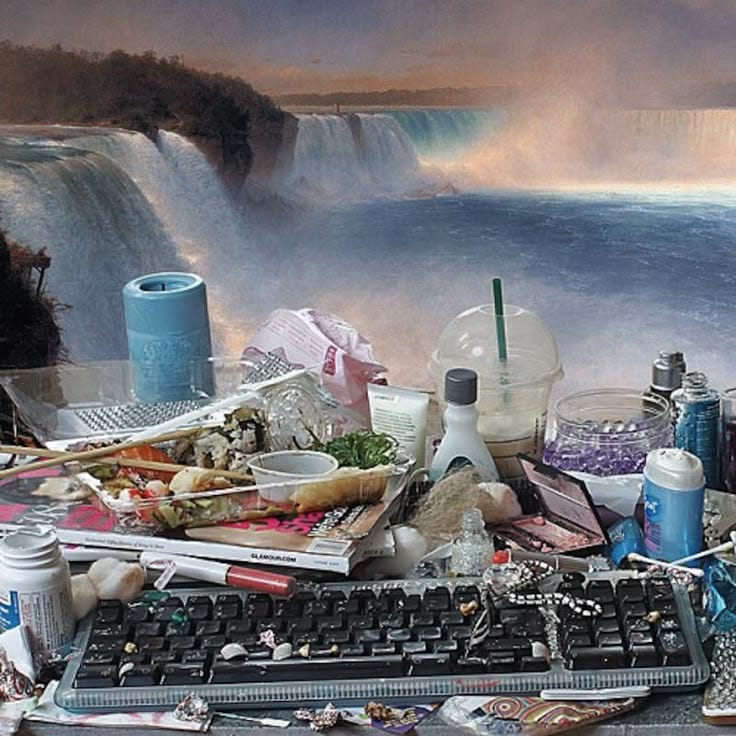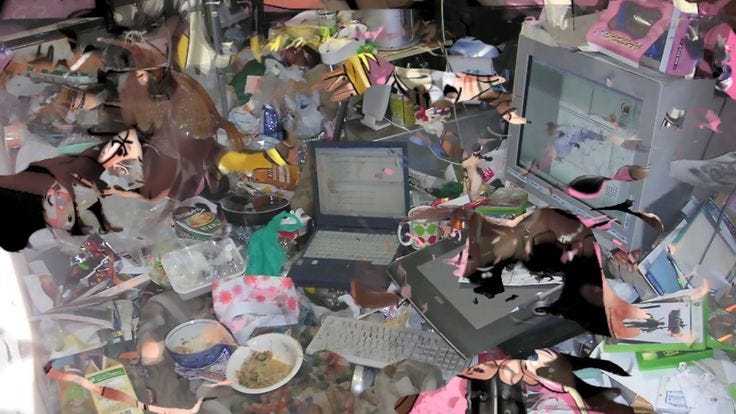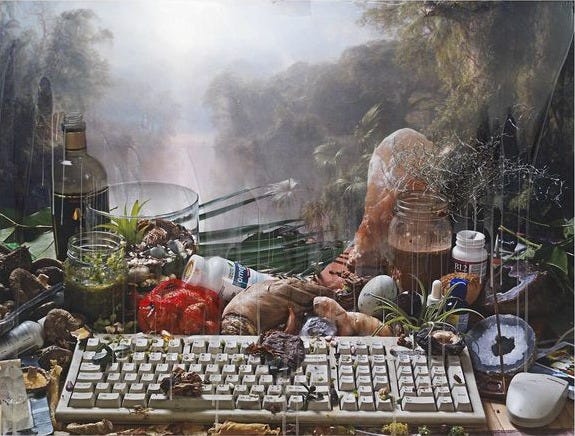Cover by Jon Rafman (with overlay)
Time has always bent to reflect our alignments. If the 60s as we know them didn’t begin until the starting gun shot through JFK’s skull in ‘63, and ended abruptly in August ‘69 with the Manson murders, then maybe the 20s- the 2020s- begin here. Finally. Far enough from the pandemic that most of us have managed to claw our way back to something that feels normal.
Or maybe this is where they end, gasping in the fresh sunlight. One imagines the band who provided hopeless accompaniment to the sinking of the Titanic happy. I cannot stop this ship going down, but I can soothe. Delight, even. We are fractals cracking through the ice into patterns, we are halls of mirrors replicating the same image smaller and smaller until it disappears into itself. We are ouroboros, damned by our propensity to create, ever-so enthusiastically, the same reality for ourselves that we’ve just escaped.
Our problem is that we think inspiration functions like a collage. You cut and paste the parts you like, forming a montage of everything that’s ever piqued your interests. Art is supposed to be gestalt, more than the sum of its parts, but when each of the parts has been plucked like a wilting flower from its roots, this is less possible.
We’re stuck in a spiral of what we see as inspiration, but is more accurately just imitation. The thing about a spiral is that you’re only ever a few degrees off from getting out of it- meaning I have hope. My fear- and I’ll have to break the stringy prose to describe it- is that most of the art we see as being boundary pushing (the up-and-coming designer you’re obsessed with, the show you have to go to) comes from rich kids. It feels like boundary pushing for the sake of boundary pushing, so that in thirty years time, when they make the documentary about it, someone will say ‘wow, you saw her and you just knew she was something special’.
The best way to be inspired is by people’s values, or techniques. You can respect the honesty in their art: naturally, that honesty would look different on you. Their choice to oppose what’s popular, their commitment to the unreal, the way they so carefully construct a feeling that we all know, but hadn’t considered before. Whatever it is. It can and should look different on you.
Fashion is the most obvious example, almost an analogy for how this works. When you see an ensemble on someone else, you could buy each piece and wear it yourself, or you could consider what you like about it. What does it say about them, and, if that’s so important, how can you showcase that part of you? Maybe you’d wear that skirt entirely differently, maybe that jacket could mean something else on your body. To be inspired is not to cosplay as someone you find interesting, it’s to realise that to be interested is valuable, and as long as you still have that spark, you can do something with it.
Andy Warhol spoke about this, in a way that, to me, implies a universal conundrum: is appearing to be like a certain kind of person a shortcut to being them? Is it better to hold that image in your heart and never imitate it?
“So today if you see a person who looks like your teenage fantasy walking down the street, it’s probably not your fantasy but someone who had the same fantasy as you and decided instead of getting it or being it, to look like it, and so he went and bought that look you both like. So forget it. Just think of all the James Deans and what it means.” - The Philosophy of Andy Warhol: From A to B and Back Again
There’s a kind perversion that runs through that feeling of I want what you have. A sweet tinge in the threat of it. It’s part of what keeps us human. The real question, when you find yourself looking into the eyes of someone who is everything you want to be, has everything you want to have, is what you’re willing to do to get it.
The wine had soured without me realising until I’d swigged the final drop, that catches in the back of my throat along with a fizzing tablet. I push red from a pocket tray into my lips with my middle finger, fur around my wrists sitting like shackles. I look like someone I would call contrived, from a distance. Of all my mother’s fears, she never predicted the worst thing I could’ve turned out to be: someone who tries too hard.
I treasure these walks down the canal, drenched in black but for the rows of windows burning opposite. Curtains flung open without shame, every one of them, forming a hive of gold-lit squares tessellating like one half of a runway for me to follow home. These flats with their warm glow seeping out into my periphery, siren call for me to topple their way, the water, slime-filled water between us graciously swallowing me in the process. I ache for a version of myself, maybe in some utopian future, who calls one of them her home. But what do they look like from the inside, with no dark to rebel against? From the other side of the pane of glass, from within the glow.
My boots clack along the pavement and I want to keep listening to Visions of Johanna for the sake of the tired looking woman unlocking the narrowboat door, glancing up in my direction as she does so, but my pulse is moving too fast for that. I’m sorry, boat woman. I switch to Nelly Furtado.
I stumble over my own syncopation, scratching for my phone in a pocket that’s deeper than my forearm. I realise I’m striding as quickly as my heels allow and come round the corner half knee-bound, sucking on the air I swallow like ice. I feel a vertical crack appear down the centre of my chest, splitting me open with a sound that echoes around the high walls of this canal lock. I’m palm ripped from palm in a chain of paper dolls, the same shape sliced of concertina, borne unendingly of my own image with no original self to credit. The source, long-since crumbled, is in your peripherals when you turn your head too quickly. The version of yourself you tried to get away from with adornments and talismans.
[That part’s the auto]
We’re all bored brainless of what I’ve come to term the ‘stale gaze’. Everything feels referential. Very little is surprising now. We experience a hundred different outfits, songs, ideas, ways of being, before breakfast, and none of them excite us. Maybe it’s the way we see what everyone’s doing all the time, bombarded with other people’s lives. Maybe it’s because we’re desperate to go back. wherever back is. Either way, it’s stunting us, and it’s not inspiring anything.
It’s fairly justified, with the pattern of digital and physical enshittification only getting stronger. Of course we’d want to recreate the magic of old films, vintage clothes, pre-tech scenes. It’s not just nostalgia, there was a higher quality, higher effort even in all kinds of art made just a couple of decades ago. They just don’t make them like they used to. All we do is try to make them like they used to.
I’m not sure what our current era of art, of culture, will be looked back on as. I guess that’s always the case- 2016 felt like a nothing of a year, and now the teens yearn for Snapchat dog and Instagram Valencia filters, Wolfie Cindy at the height of her fame, and not knowing that front men of your favourite bands were all twats. The trend cycle feels like it’s slowing right down, at least compared to the runaway train it felt like a year or two ago, and there’s less beige being forced down our throats- the whole neutrals movement has faded, somewhat. Maybe I’m just less online than I used to be. But most of the big visuals we see now hark back to the 90s, y2k, digital camera shots and wearing outfits we might have seen on Disney channel as a kid. Playing dress-up to match the images we grew up with. So many hit songs seem designed to make you feel like you’re part of a scene in a movie from the 80s, electronics and disco and spinning under strobes. Sequels and remakes lead the film industry, and, combined with the number of biopics in cinemas, allowing us to obsess over icons of the past who can’t be recreated, audiences are getting tired of it.
It’s always been normal for trends to resurface, and no art can exist in a vacuum, but it feels a little like we’ve gotten lost in trying to recreate the appeal of previous looks. Perhaps this is why y2k’s stuck around for so long, around 5 years in various forms- what happens when we catch up with ourselves? There are still plenty of people pushing boundaries, and fashion has always run in cycles, distorting our memories of what it used to look like in the first place, but so much of it is a reflection of a reflection of a reflection. There are sparks, but we’re so flooded with light that it’s hard to see. Maybe we truly have just run out of road. At least there’s more to work with here: we’re going back to basics in fabrics, lighting, print media, necklines, angles, instruments. Plenty of space to change up what we do with them. We have more potential beneath our fingertips than ever before and we spend it trying to crawl our way back. And since we’re all, each of us, walking brands now, that applies to the personal, too.
To demonstrate an understanding of the artists that came before you is important, but that is not synonymous with ability, or inspiration. To be inspired is not to select specific elements and symbols to take on yourself, like you’re fourteen again explaining to your friends that you want Selena Gomez’s smile and Vanessa Hudgens’ eyes. To appreciate something in someone else is often more of a symbol of your own passion, the things that pique your interest, unique in its combination. But we seem to have a tendency to stop there. I liked it, so I bought it. I put it on my wall.
When I was younger, I knew I loved to read, and so would come home from charity shops with stacks of cheap classics that I was told were the pinnacle of literature. I was voracious in my acquisitions, tepid in my ability to swallow come the event itself, at a time when what I needed was lightness and escape. Now, as an adult, I’m grateful for that mostly untouched collection. It feels like a library when I return to my home, an endless supply of books I’m finally ready to engage with. But it made my childhood bedroom a foreign place. It’s full of artefacts that were never actually part of the person I was.
I watch myself making the same mistakes today, reading certain books not out of enjoyment, but in the hope that their genius will seep into me, and I’ll become greater than myself. I avoid modern writing written in voices that seem similar to mine but with more talent and experience, out of fear that I’ll accidentally take them on entirely, and everything I write will be an unknowing imitation. You can see, clearly, the issue with this. Though I tell myself I know what it is I’m trying to tap into, I don’t have the map to get there. I fear that if I did, I’d somehow be cheating, as though that’s not how art has moved for as long as there’s been movement.
[That part’s the fiction]
It’s all a form of desire, that elusive thing. To hold around you the trinkets of another and create work that imitates theirs, is to inhabit their life. The best way to be close to someone without being able to touch them is to imitate them.
The person you’re looking up to is often just better at that imitation than you, by nature, or resources, or sheer luck. You can buy the clothes, master the hairstyle, get yourself an invite into the room, find rows of welcoming hands waiting to clasp yours and kisses ready to implant onto your cheek when you get there, but it’ll never feel like yours if you only wanted it to prove that you could have it. If you only wanted it because it once belonged to someone else.
No one wants to tell me that I’m reaching the end of my shelf-life, but I can see it reflected in their expressions. We’re all salespeople, in the end. Products have a sell-by date. Markets move. You’ll outstay your welcome no matter how you let the light sit across your face, or how knowingly you smile. My usefulness is finite.
I’m the sinking ship more so than the doomed violinists twisting a rhythm on its deck. I am strings sighing through every otherwise silent moment. I am the scar on your arm where you couldn’t prize my teeth away, where you kept tearing the scab from your skin to create proof I was ever there. Memories that scarcely survive a day are flashes of sight, colours, touch, and sound. The ones you keep are mostly semantic: they’re encoded in meaning. They are meaning. They’re infinite, theoretically, and since the more you visit them the stronger they are, trying to chip away at the thing only reinforces it.
To be inspired is a precious thing. Unrivalled and vital. It’s how you let that inspiration reverberate through you, and how you enact it with love rather than desperation, that counts. You can be a collage of everything you’ve ever liked looking, hearing, experiencing, but it has to be tinted in the hue of your own output to ever be fulfilling. To turn inward, to your own core and ask- what it is about you that made you look twice?
if you enjoyed this and want to support me to be able to keep writing, you can buy me a coffee here :)









I loved this! I think often as beginner artists we lean more heavily on imitation and then hopefully as we grow and practice, we're able to use what we like to inspire what we will uniquely be and create as artists --- which is hopefully distinct from whatever is trendy, something lasting. Really enjoyed this essay!
You are always phenomenal. This essay has made me think in so many ways; I’m behind my screen hanging onto your every word. Thank you. But no shelf life for you. You’re too good! ❤️